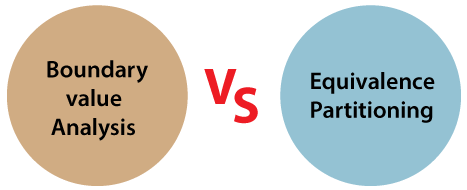Difference between Boundary value analysis & Equivalence partitioning
In this section, we are going to discuss some of the important differences between Boundary value analysis and Equivalence Partitioning.
As we already know that both Boundary value analysis and Equivalence Partitioning technique are part of test case design techniques in black-box testing.
But before we see the difference between Boundary value analysis and Equivalence Partitioning, first, we will understand both the terms in brief.
What is Boundary value analysis?
It is one of the extensively used test case design techniques for black-box testing. In this, we will test the boundary values as the input values near the boundary have higher chances of error. It is applicable at all levels of the testing process.
Whenever we perform the boundary value analysis technique, the test engineer focuses on entering boundary value whether the software is creating correct output or not.
What is Equivalence partitioning?
Another test case design technique is Equivalence partitioning, which is derived from the software’s requirements and specifications. To cover maximum requirements Equivalence Partitioning uses the minimum test cases.
In this, the test cases should be designed to cover each partition at least once. And each value of every equal partition must display the same behavior as the other.
Boundary value analysis Vs. Equivalence partitioning
In the below table, we have listed some of the important difference between
Boundary value analysis and Equivalence partitioning:

| S.NO. | Boundary value analysis | Equivalence partitioning |
|---|---|---|
| 1. | It is a technique where we identify the errors at the boundaries of input data to discover those errors in the input center. | It is a technique where the input data is divided into partitions of valid and invalid values. |
| 2. | Boundary values are those that contain the upper and lower limit of a variable. | In this, the inputs to the software or the application are separated into groups expected to show similar behavior. |
| 3. | Boundary value analysis is testing the boundaries between partitions. | It allows us to divide a set of test conditions into a partition that should be considered the same. |
| 4. | It will help decrease testing time due to a lesser number of test cases from infinite to finite. | The Equivalence partitioning will reduce the number of test cases to a finite list of testable test cases covering maximum possibilities. |
| 5. | The Boundary Value Analysis is often called a part of the Stress and Negative Testing. | The Equivalence partitioning can be suitable for all the software testing levels such as unit, integration, system. |
| 6. | Sometimes the boundary value analysis is also known as Range Checking. | Equivalence partitioning is also known as Equivalence class partitioning. |
Conclusion
After seeing all the major differences between Boundary Value Analysis and Equivalence Partitioning, we must conclude that the boundary value analysis is a better approach than Equivalence Partitioning.
Suppose testing values are repeated while comparing Equivalence Partitioning and Boundary Value Analysis. In that case, we can neglect the Equivalence Partitioning and perform only Boundary Value analysis as it covers all the values.
Therefore, the Boundary Value Analysis proves to be a good option in assuring the quality after the Equivalence Partitioning technique.
